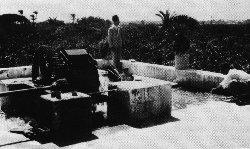
By: Dr. Rudolf T. ZarZar

Orange grove at Bir Salem, near Ramle. In 1944, this village had 315 acres of Irrigated crops and 370 acres of field crops.
There are two variations of this theme in Zionist literature. One derives from the myth that Palestine was uninhabited, hence a "desolate wasteland" that Zionist colonists settled and developed. A second variation, found in the novels of Leon Uris, would have it that Palestine was once a rich and fertile land, a land, indeed, of milk and honey, but centuries of Arab and Turkish neglect transformed it into "stagnated swamps and eroded hills and rock-filled fields and infertile earth ... a land that lay bleeding and fallow [until] Jews rebuilt it." [Uris, Exodus, pp 216, 266; see also hisHal, pp. 17, 39 et passim.]
Nothing could be further from the truth. A British missionary who visited Palestine in 1859 described its southern coastal area as "a very ocean of wheat." This testimony is confirmed by a British consul in Jerusalem, James Finn, who wrote that "the fields would do credit to English farming." And a German geographer, writing of Palestine's economy during the twenty years preceding Jewish colonization, reported that it had "experienced a remarkable economic upswing" based on agriculture, resulting in a favorable balance of international trade. Even U.S. Supreme Court Justice Louis Brandeis, an ardent Zionist, wrote of his visit to Palestine in 1919 that the view from the Mount of Olives in Jerusalem was more beautiful than California and that "all yet say that northern Palestine is far more beautiful" - a quote I would ask readers of this booklet to keep in mind as they note the number of Palestinian locations in northern Palestine destroyed in 1948. This is particularly true of the Jaffa area. Here the famous Jaffa orange groves produced 36 million oranges in 1880, of which 19 million were exported to Europe and elsewhere. [For references on the above quotes, see M. Hallaj's "From Time Immemorial: The Resurrection of a Myth," in The Link, vol. 18, #1.]